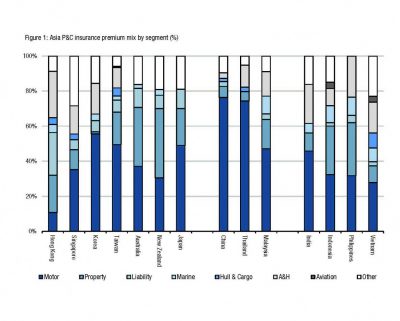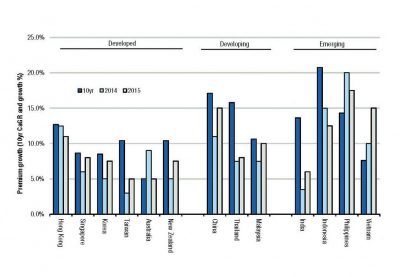
Asian Insurance – Still a profitable high growth market for the next decade?
Historical Growth Strong
The Asian insurance market has outgrown most other markets globally over the last decade; underpinned by strong economic growth and development, and aided by positive demographics, especially a rapidly emerging middle class.
The Asian life insurance market totalled around US$1tn in premiums in 2013[1], with most markets still mainly focused on ‘savings’ style products rather than mainly ‘insurance’ style products like Australia. Excluding Japan and Australia/NZ, total premiums for the rest of Asia totalled ~US$450bn, having grown at 13.5%[2] p.a. over the last decade – relative to 7% p.a. for Australia/NZ, 3.5% p.a. for Japan, 2% p.a. for North America and 5.5% p.a. for Western Europe.
The Asian general (P&C) insurance market remains much smaller than the life market, with total premiums of just over US$400bn[3] in 2012. Excluding Japan and Australia/NZ, total premiums for the rest of Asia totalled US$225bn, having grown at 15%[4] p.a. over the last decade – relative to 12% p.a. for Australia/NZ, 3.5% p.a. for Japan, 3.5% p.a. for North America and 6% p.a. for Western Europe.
Differing Products, Distribution and Profitability
Product types, distribution channels and profitability vary considerably amongst the 14 major markets in the region.
For life insurance, products still are mainly savings orientated, with traditional participating products dominant in many countries. The rise of unit-linked products was severely impacted by the Global Financial Crisis, as investors switched back to what are considered safer forms of investment.
For general insurance, the main market segment is motor insurance (see Figure 1); which for example in China represents over 75% of the market, with the retail home insurance (either building or home and contents) almost non-existent.

The independent agency / broker channel is still in its infancy in most of Asia, with tied agency forces and bancassurance being the major methods of distribution for life insurance. Bancassurance is becoming an increasingly important distribution channel, with upfront prices paid by insurers for long term exclusive distribution deals having gone up materially in the last few years (for example, AIA Group paid US$800mn upfront for a 15 year exclusive distribution deal with Citibank in Asia in late 2013).
For general insurance, the direct market is still evolving gradually, with only the Japanese, Korean and Australian markets being dominated by the direct channel. Agents and dealerships are still material distribution channels in many of the remaining Asian markets.
Profitability also varies materially by market in both life and general insurance across Asia. For life insurance, markets that have historically offered high long-term guaranteed products (i.e. Taiwan, Korea and Japan), have struggled with profitability as interest rates have fallen, with new business margins also still lagging despite consolidation in these markets.
The Hong Kong and South East Asian markets have the most attractive new business margins in Asia, especially for scale insurers focusing more on ‘insurance’ sales. Many of these markets also have higher levels of unit-linked sales (with insurance riders), which also have lower capital requirements. Part of the reason these markets are more attractive is due to higher market share of international insurers and the continued dominance of tied agency forces. We see little pressure on margins in the near term given the distribution and (bundled) product mix in these markets.
For the general insurance market, profitability is quite varied by market (see Figure 2), with weaker markets suffering from lack of rational competition (e.g. India), tariff distortions (e.g. Malaysia) or natural catastrophes (e.g. Thailand, New Zealand, Japan). Overall, this market is much more fragmented across Asia due to its smaller size, tarrification and regulation.

Overall Outlook Still Strong – But Varies by Country
We remain positive on both the growth and profitability outlook for both the Asian life and general (P&C) insurance markets over the next decade.
However, this does vary quite a bit by market; with some requiring major structural change (i.e. India) and others needing insurers to adapt their business models and products for rapidly ageing populations (i.e. China).
China and India represent 75% of the population of Asia and are therefore key to the future growth and profitability of the Asian insurance markets.
India has major issues in the profitability of its insurance industry for both life and general insurance due to government participation in the market and over- zealous regulatory initiatives (which on the life insurance side have shrunk the industry materially). Unfortunately, we see little likelihood of change in the near term.
Conversely, Chinese regulators have on various occasions prevented the insurance sector from spiralling into unprofitable cycles; with the key issue being the focus on volume (generally at the expense of margins) by a large part of the market (including the large SOEs).

We see a huge medium term opportunity in the general (P&C) insurance market in many of the developing and emerging Asian markets as they de-tariff and consolidate. There will be a shift towards direct channel sales; with companies like IAG, AXA and Allianz already positioning themselves for this. We see this opportunity as having largely passed in most of the life insurance markets; with companies like AIA and Prudential the larger of the regional insurers having led the charge, now enjoying significant competitive advantages (especially scale) in the key distribution channels.
Whilst China and India will continue to drive growth for the region (see Figure 3), we see the South East Asia market as the key drivers of profitable growth in the region nearer term.
Figures 1 – 3: Source: Local regulators, Credit Suisse
- Swiss Re, local regulatory data.
- To end of 2013.
- Swiss Re.
- To end of 2014.
CPD: Actuaries Institute Members can claim two CPD points for every hour of reading articles on Actuaries Digital.






